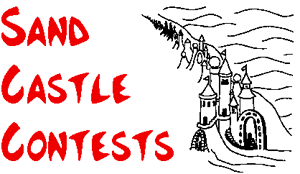
 |
Setting Up a Sand Castle Contestby sandy feetFrequently Asked Questions |
|
A few caveats here: There is no magical formula for setting up a masters-level contest. Each contest is different and maintains a distinct personality shaped by variables that include the environment, sponsorship and the distinct personalities of the organizers.
These are some of the questions I frequently get from organizers and my answers - based on 14 years of experience at both competing and organizing contests. Other contest organizers might answer them differently so feel free to query them as well. I am basically trying to save myself from having to reinvent the wheel over and over again. I will continue to add and alter this page as input and time permits. >(1) at what distance from the shore should the demarcation of space begin? This largely depends on two factors: tidal trends and water source. Assuming these beaches are located on the ocean (correct me if I am in error), you will of course want to locate the sculptures above the high-tide line, especially in a two-day event. On the other hand, sand sculpture requires a lot of water and if the builders will have to carry their own water in buckets from the shoreline, you are handicapping them if they have to carry it very far. At our event, we hook up a lot of hoses and place plastic trashcans strategically among the building plots and assign a volunteer the task of keeping the trashcans filled with water so that the sculptors can scoop it out with buckets. >(2) What tools are necessary? (Do we provide same or do the contestants?) buckets (5-gallon or the local equivalent, about 3-5 buckets per sculptor); shovels; carving tools; stakes and surveyor's tape for marking plots; and white glue diluted with water and garden-type sprayers (these are optional but a good idea for a two day event. spraying the glue on carved pieces protects them from wind/rain and drying out prematurely. Elmers glue is non-toxic and bio-degradable and will not affect the environment. Overnight security is also and important issue on a two-day event.) Sculptors who drive to the event can be expected to provide most of the above - with the exceptions of the stakes and tape and glue and sprayers. Sculptors who fly in may need help in procuring shovels and buckets. All sculptors travel with their favorite carving tools. Many master-level sculptors prefer to work with forms. (My partner and I do not.) These forms are constructed from plywood and 2x4s and most sculptors will be willing to build their own based on the shape of their sculptures -- plan on an extra day for this activity prior to the contest start time. At our event we help as much as we can with providing construction tools, some labor and a cheap and acessible source of wood and nails. Since this is something that the sculptor will NOT be bringing back on the plane with him/her, we store them locally and make them available to next year's competitors. >(3) How much space is allowed for construction? Most two-day solo events give each competitor a 20' x 20' plot. At our event we bring in a sand grader prior to the contest and push up equal-sized piles of sand in each plot so the competitors can spend more time carving and less time shoveling. >(4) Do we allow more than 1 or 2 floors per edifice? Not sure I understand this question. Sculptors who use forms will probably want to stack them 2-4 levels high if they think the sand can handle it. (If the sand has a high natural clay content, it will stack higher.) Spectators are impressed by height and it is frequently part of the judging criteria. >(5) Judging is relative to specfic sets of rules? What are they? Ah, now THERE is a tough question! There are some fairly common rules, such as only sand and water used (no artificial decorations allowed); no power tools allowed (such as water pumps or sand-moving machines) and no assistants within the plot (though water carriers to the plot are usually allowed.) The actual judging criteria is a different thing altogether and the cause of much dissension among the sculptors as well as headaches for organizers. You may of course judge by whatever criteria you like though it would be a good idea to determine and publish same well in advance of the contest so that the sculptors are aware of what the judges are looking for. GENERALLY speaking, sculptures are judged in the following areas: originality (clever idea, fresh approach, etc.); technical difficulty (cut-throughs, height, overhangs, pushing the sand to its limits); faithfulness to theme (if there is one); execution (did the sculptor succeed at what s/he set out to do? Does the piece "read"?) and use of space (carved and finished all the way around, are there large expanses of open space? etc.) |
[tips & tricks] [carving tools] [contests] [photos/links] [sculptor list] [sculptor news] [sandcastle central]
This page brought to you by